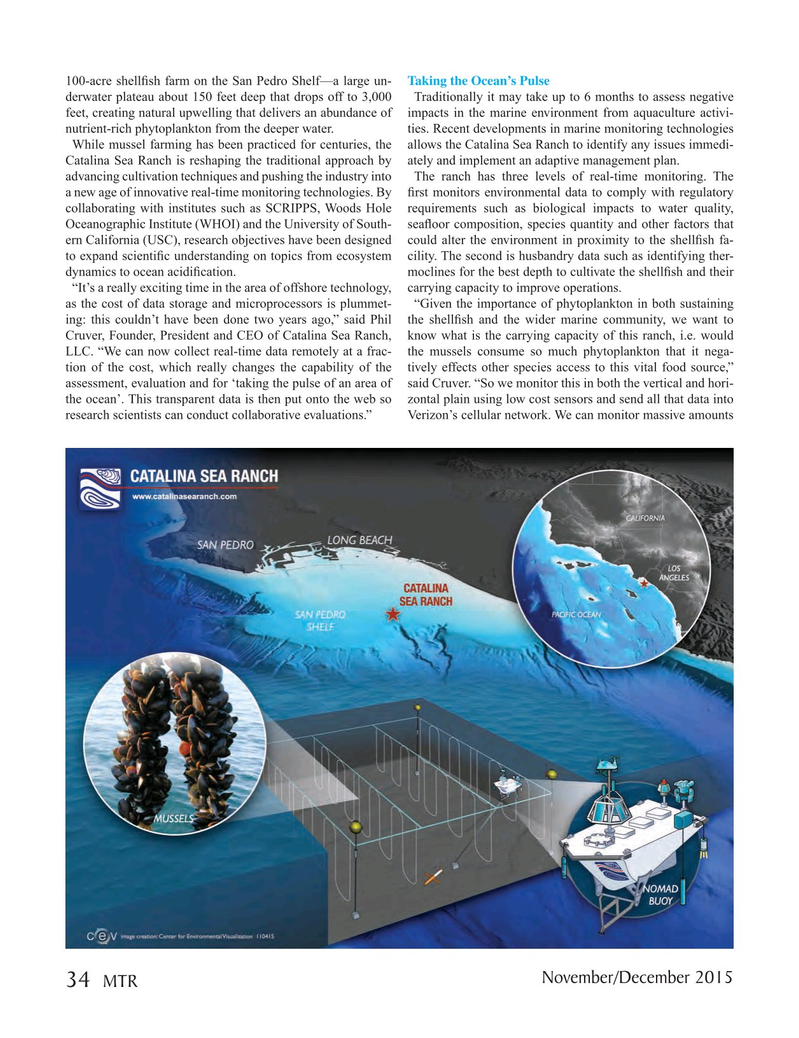
Page 34: of Marine Technology Magazine (November 2015)
Read this page in Pdf, Flash or Html5 edition of November 2015 Marine Technology Magazine
100-acre shell? sh farm on the San Pedro Shelf—a large un- Taking the Ocean’s Pulse derwater plateau about 150 feet deep that drops off to 3,000 Traditionally it may take up to 6 months to assess negative feet, creating natural upwelling that delivers an abundance of impacts in the marine environment from aquaculture activi- nutrient-rich phytoplankton from the deeper water. ties. Recent developments in marine monitoring technologies
While mussel farming has been practiced for centuries, the allows the Catalina Sea Ranch to identify any issues immedi-
Catalina Sea Ranch is reshaping the traditional approach by ately and implement an adaptive management plan.
advancing cultivation techniques and pushing the industry into The ranch has three levels of real-time monitoring. The a new age of innovative real-time monitoring technologies. By ? rst monitors environmental data to comply with regulatory collaborating with institutes such as SCRIPPS, Woods Hole requirements such as biological impacts to water quality,
Oceanographic Institute (WHOI) and the University of South- sea? oor composition, species quantity and other factors that ern California (USC), research objectives have been designed could alter the environment in proximity to the shell? sh fa- to expand scienti? c understanding on topics from ecosystem cility. The second is husbandry data such as identifying ther- dynamics to ocean acidi? cation. moclines for the best depth to cultivate the shell? sh and their “It’s a really exciting time in the area of offshore technology, carrying capacity to improve operations. as the cost of data storage and microprocessors is plummet- “Given the importance of phytoplankton in both sustaining ing: this couldn’t have been done two years ago,” said Phil the shell? sh and the wider marine community, we want to
Cruver, Founder, President and CEO of Catalina Sea Ranch, know what is the carrying capacity of this ranch, i.e. would
LLC. “We can now collect real-time data remotely at a frac- the mussels consume so much phytoplankton that it nega- tion of the cost, which really changes the capability of the tively effects other species access to this vital food source,” assessment, evaluation and for ‘taking the pulse of an area of said Cruver. “So we monitor this in both the vertical and hori- the ocean’. This transparent data is then put onto the web so zontal plain using low cost sensors and send all that data into research scientists can conduct collaborative evaluations.” Verizon’s cellular network. We can monitor massive amounts
November/December 2015 34
MTR
MTR #9 (34-49).indd 34 12/8/2015 10:44:17 AM

 33
33

 35
35
